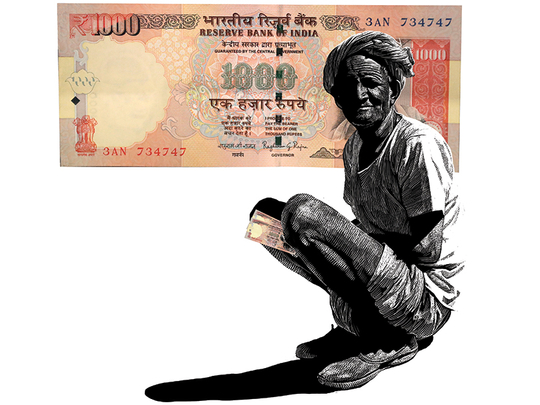
‘Money is what money does’, there goes the saying.
Well, look what it is doing to Asia’s third-largest economy!
Deaths, frayed nerves, wiping off of cash savings, missed payments, vandalism at banks ... short-changed — literally.
On the evening of November 8, when the world was glued to television sets to see whether or not America elects its first female president, 1.25 billion Indians were holding on to their breath, trying to catch the bottom line of Prime Minister Narendra Modi’s unscheduled address to the nation. Post-midnight, Rs500 and Rs1,000 bills will cease to be legal tender, said the prime minister. In one fell swoop, the government (read Modi) wanted to crack down on the ill-gotten gains of the corrupt and the unscrupulous, referred to as “black money” in common parlance – with Rs500 and Rs1,000 bills or notes being the most preferred option for such hoarding of cash.
It’s been 11 days since the announcement.
In these 11 days, India’s retail domestic trade and its banking system have been thrown into a complete disarray – thanks to a general panic that has set in among the public over sudden demonetisation of the most popular denomination of currency notes in the second-most populous country in the world. While the supply of new Rs500 and Rs2,000 notes is still just a trickle, a ridiculously low cap on daily withdrawal limits from bank accounts has further deepened anxiety over money supply.
So far, 33 people have died across India, primarily owing to exhaustion from waiting in long queues outside banks or ATMs, looking to get banned bills exchanged with new ones or ones of smaller denominations or to simply make a transaction on their accounts. ATMs have been vandalised at several places, bank employees and even law keepers have often found themselves at the receiving end of public ire over demonetisation.
Just for the sake of a bit of number-crunching, 86 per cent of India’s currency notes used to be in denominations of Rs500 and Rs1,000 — the most preferred for high-value transactions. And there lies the crux of the matter. ‘High-value’ transactions are the ones that bear the maximum possibility of seeing money change colour from white to grey to black. While the use of plastic payment devices such as debit and credit cards, electronic fund-transfer channels and e-wallets are fast gaining popularity, the fact remains that in India, cash is still king — unlike the United States where more than 80 per cent of all transactions is cashless. Moreover, half of India’s total output comes from the informal sector where the use of plastic money or electronic payment channels is almost nonexistent. At the same time, millions change hands daily through bribes, under-invoicing, over-invoicing, bogus bills and so on in an economy where total black money is estimated to be $460 billion (Dh1.69 trillion) a year — which is about 20 per cent of the country’s gross domestic product.
Demonetisation, as a fiscal tool, is neither new nor unique to India. It means stripping a currency of its value as legal tender. It usually becomes necessary whenever there is a change of currency. In 1954 and 1978, the Indian government had undertaken demonetisation drives, though with only limited success so far as flushing out black money was concerned.
While one can understand and appreciate the intentions behind the latest demonetisation move, the risk that this particular brand of anti-black money crusade runs cannot be glossed over in a hurry. While the jury is still out on the efficacy of the move in weeding out black money from the system, the inconveniences it has caused already appear to be humongous.
Importance of going cashless
But looking at the entire issue from the other end of the spectrum, one cannot but marvel at the challenges that a crisis like this can throw open. For instance, the current rupee crunch once again proves the importance of bringing more and more people under the banking system. This crisis has once again highlighted the importance of encouraging consumers to go cashless whenever and wherever possible and that there is a genuine need to incentivise cashless transactions. For instance, even today, credit card transactions in India, like in many other places of the world, often invite a 2 per cent service charge that is passed on to customers. The time has perhaps come to do the opposite – let consumers be rewarded for using plastic money instead of cash and let such incentives be institutionalised. The current crisis also calls for an urgent need to make it mandatory to impose a cash ceiling on all high-value transactions and a complete overhaul of the tax structure in India. A broader net, but with reduced rates, can help ensure lesser haemorrhage of revenue and encourage tax-payers to be less dodgy when it comes to disclosing sources of income.
There are a few upsides too to the current cash crunch.
The homemaker’s kitty of those soiled, almost torn, humble and neglected Rs100, Rs50 and Rs20-tenders are now suddenly worth their weight in gold. The grocery shop owner round the neighbourhood kerb has just got the entrepreneur in him out on the forefront, asking all his customers to transfer their spends to his mobile e-wallet! Rural and semi-urban India is probably waiting to see a surge in the number of bank accounts opened by first-time users — let’s beat the next demonetisation. Cell phone shops are possibly experiencing a hike in demand for selfie-sticks: The all-new Rs2,000 notes call for an urgent Facebook status update! And there are reports of free coffee being served by a major beverage chain in New Delhi, Mumbai and Bengaluru to those waiting in long queues outside ATMs.
You see, cash is still king, And yes, money indeed is what money does.
You can follow Sanjib Kumar Das on Twitter at www.twitter.com/@moumiayush.









